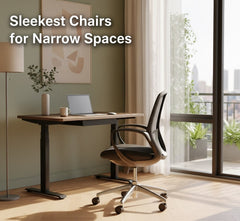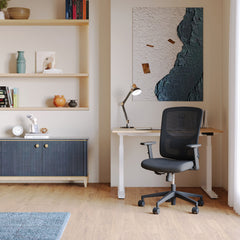Get 10% off your first order
Find the office furniture that’s designed to match your style, comfort, and needs perfectly. Subscribe
Sleekest Chairs for Narrow Spaces

Visit quiz page to see how we makes it easy to create an inspiring workplace


The term "ergonomics" often conjures images of expensive, high-tech chairs and motorized desks. While premium gear offers convenience, achieving a truly healthy workstation is less about your budget and more about understanding fundamental alignment principles. You can create a comfortable, pain-free setup right now, using items you already own, simply by making smarter choices about positioning and posture.
A healthy workspace is one where your body is in a neutral, relaxed position, minimizing strain on your muscles and joints. This principle holds true whether you are using a $5,000 professional setup or carefully arranged household items. By focusing on the core principles of screen height, elbow angle, and lumbar support, you can eliminate the physical distractions that break your concentration and lead to long-term discomfort.
Effective, low-cost ergonomics rests on three pillars: using adjustable items you own, leveraging your physical space creatively, and committing to dynamic movement. The goal is to adapt your existing furniture to fit your unique body, rather than adapting your body to fit fixed furniture. This proactive approach saves your health and your wallet.
For those who may consider future investments, flexibility remains the key. A premium, adjustable desk can be a game-changer when you are ready to upgrade. A height-adjustable standing desk offers the full range of dynamic movement necessary for optimal health, ensuring any investment serves your body perfectly.
The monitor height is the most critical element of your setup for preventing neck and upper back pain. If your screen is too low, you crane your neck forward, creating immense strain (known as "tech neck"). The simple solution is to raise the screen so the top edge is at or just below your eye level.
You do not need an expensive monitor stand. Books, reams of paper, or sturdy boxes can easily achieve the correct elevation, provided the stack is stable. The trick is to ensure your entire eye line is supported.
Steps for Correct Monitor Elevation (Enumeration):
Sit Tall: Sit with your back straight and shoulders relaxed.
Stack Stable: Place a stack of books or a printer paper ream on your desk.
Check Height: Place your monitor or laptop on the stack; the top of the screen should be at eye level.
Confirm Stability: Ensure the stack is firm and will not wobble or collapse during use.
This no-cost adjustment immediately relaxes the muscles in your neck and shoulders, making long hours of focus significantly more comfortable.
The correct elbow angle ensures that your shoulders remain relaxed and your wrists stay neutral while typing. Incorrect height forces your shoulders to shrug up toward your ears, leading to tension headaches and upper back pain. Your arms should hang loosely at your sides, with your elbows bent at a comfortable 90 to 100 degrees.
If your existing chair has fixed armrests that are too low or too high, you have options beyond buying a new chair. The desk surface itself can serve as a guide.
Raise Low Armrests: Use small, firm cushions or folded towels taped securely to the armrests to bring them up to the correct height.
Remove or Lower High Armrests: If possible, remove fixed, high armrests that prevent you from getting close enough to the desk, or find a cushion to raise your seat height to compensate.
Utilize Desk Surface: Ensure your desk surface allows your keyboard to be positioned so your arms form the proper angle without forcing your shoulders up.
A minimalist desk design aids this process by eliminating bulky drawer units or strange cutouts that prevent close, neutral positioning. A clean-line surface like a modern office desk provides the most flexibility for positioning keyboard and mouse optimally.
Your lower back (lumbar spine) has a natural inward curve. If your chair is flat, that curve collapses, putting immense pressure on your spinal discs. You can fix this immediately without an expensive chair.
The best lumbar support fits your unique curve precisely. A tightly rolled towel or a small pillow works perfectly to fill the gap between the chair back and your lower spine, supporting the natural curve.
Lumbar Support DIY (Checklist):
☐ Roll: Take a medium-sized towel and roll it tightly.
☐ Position: Place the roll horizontally across the lower back of your chair.
☐ Test Height: Adjust the towel roll up or down so it sits right in the curve of your lower spine (just above your beltline) when seated.
☐ Test Firmness: The support should be firm enough to maintain the curve but comfortable enough for hours of work.
Many people overlook the importance of their feet and the correct seat depth. If your feet dangle, pressure builds up under your thighs. If your seat is too deep, the back of your knees hit the seat edge, restricting circulation. Both issues steal energy and lead to discomfort.
If your chair is too high (even after adjusting it), do not let your feet dangle. This is poor for circulation and stability.
Footrest Solution: Use a sturdy stack of large books, a shoebox, or even a small wastebasket placed on its side as a footrest. Your knees should be roughly level with your hips.
Seat Depth Fix: Ensure there are 2 to 4 finger-widths of space between the back of your knees and the front edge of the seat. If your seat is too deep, use a cushion placed against the chair back to effectively shorten the seat depth.
These adjustments ensure stability and optimal blood flow to your lower extremities, crucial for avoiding the midday drop in alertness.

The most crucial element of a healthy workstation is not gear; it is dynamic movement. Even a perfectly set up desk will fail you if you stay in one position for hours. The goal is to break the static posture trap regularly.
Commit to changing your position every 30 to 45 minutes. This can be as simple as standing up for 30 seconds or taking a short pacing break during a phone call. Your environment must facilitate this.
Movement Strategies (Bullet Points):
Stand Up: Set a timer to stand and stretch for two minutes every 45 minutes.
Pace: Take phone calls while walking around the room.
Hydrate: Keep your water bottle slightly out of reach to force you to walk every time you refill it.
Sit-Stand Hack: Use a kitchen counter or a tall dresser as a temporary standing desk for 15 minutes every hour.
The concept of integrating movement throughout the day is fundamental to sustaining focus and reducing physical stress, offering immense ergonomic benefits at zero cost.
You do not need specialized LED lighting panels. You need balanced, non-glare illumination. Poor lighting accelerates eye strain, leading to headaches and mental fatigue. The key is to reduce the contrast between your screen and your surroundings.
The most effective light source is natural light. Position your setup perpendicular to the window to maximize daylight while minimizing direct glare onto your screen or into your eyes.
Budget Lighting Solutions (Table):
|
Problem |
DIY Solution |
Ergonomic Benefit |
|
Monitor Glare |
Adjust monitor tilt; use a pillow to support the screen angle. |
Prevents eye strain from reflections. |
|
Dim Workspace |
Use two standard household lamps instead of one (layered light). |
Balances illumination; reduces contrast fatigue. |
|
Poor Task Lighting |
Reposition a movable desk lamp closer to documents/keyboard. |
Improves visibility for detail work. |
Noise is a major cognitive distraction. Unpredictable sounds (like traffic or conversations) force your brain to expend energy filtering them out, stealing focus. You can block this without expensive noise-canceling headphones.
Your focus environment should be predictable and consistent.
Sound Masking: Use free online ambient sound generators (e.g., coffee shop sounds, brown noise, instrumental music) streamed through basic headphones or computer speakers to mask distracting external noises.
Communication Rules: If sharing space, establish clear "do not disturb" signs or protocols to minimize interruptions from others.
Using a laptop as your primary device without external peripherals is an ergonomic fail. Your body should not have to compromise. You need an external keyboard and mouse to separate the screen height from the hand position.
If you cannot afford new gear, ask friends or check local thrift shops for gently used external keyboards and mice. Even a basic wired model will be exponentially better for your posture than using the laptop's built-in keyboard.
A proper ergonomic monitor arm is a great investment when budget allows, as it offers fluid adjustment; however, until then, your book stacks and boxes serve the vital function of decoupling the screen from the keyboard.
Small spaces present unique ergonomic challenges because every piece of furniture must serve multiple functions without causing clutter. This requires creativity in placement and a commitment to minimal design.
In tight spaces, look for furniture that is intentionally compact. For example, a Small Standing Desk Delaware is designed to fit into narrow areas while still providing the essential benefit of height adjustment, maximizing your health potential without requiring a huge footprint.
Desk as Divider: Use a desk or narrow console table to physically divide a room, creating a visual boundary that aids focus.
Vertical Storage: Use wall space for storage (pegboards, shallow shelves) rather than bulky floor-standing cabinets, which keeps the area open and clutter-free.

Creating a healthy workstation, even with minimal cost, is an act of empowerment. When you intentionally design your space to support your body and mind, you gain a sense of control over your work environment. This control has tangible psychological benefits.
The effort you put into optimizing your space, regardless of the cost, directly impacts your mental health. A study on work engagement and well-being highlights that having control over your work environment is critical for maintaining high levels of engagement and reducing burnout. The inexpensive hacks you implement are powerful tools that reinforce your personal sense of autonomy and well-being.
A healthy workstation is defined by alignment, not expense. By applying simple physics and ingenuity—using books, towels, and smart placement—you can solve 90% of ergonomic problems without spending a dime. The goal is to move, align, and organize. These low-cost solutions are powerful because they put you in control of your health. Start today by making one free change, like rolling a towel for lumbar support, and feel the difference immediately. Your body and your focus will thank you for prioritizing proper alignment over premium gear.

Sleekest Chairs for Narrow Spaces

Mastering the Wood and Metal Fusion in Furniture

Pairing the Perfect Chair with a Dynamic Desk
Get 10% off your first order
Find the office furniture that’s designed to match your style, comfort, and needs perfectly. Subscribe
Leave a comment